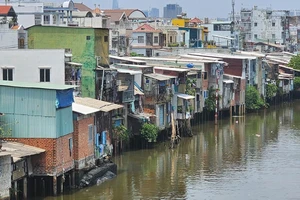 Sanitation workers pick up garbage from the Nhieu Loc -Thi Nghe canal (Photo: SGGP)
Sanitation workers pick up garbage from the Nhieu Loc -Thi Nghe canal (Photo: SGGP)
According to a team of sanitation workers of the Ho Chi Minh City Urban Environment Company who are responsible for collecting garbage on the Nhieu Loc - Thi Nghe canal, they pick up 7-8 tons of waste per day.
At the beginning of October 2022, sanitation workers said that they picked up 9-10 tons of garbage a day; worse, they even collected up to 13-14 tons a day sometimes.
Mr. Ho Hoc Hai, captain of the garbage collection team of Nhieu Loc - Thi Nghe canal complained that many people have very poor awareness of sanitation without thinking about how hard other people have to pick up trash. Many days sanitation workers have to work until 9- 10 p.m. to complete their tasks. People throw all kinds of garbage including lunch boxes, plastic bags, styrofoam boxes, and bulky garbage such as tables, chairs, and blankets.
According to Mr. Hai, 22 workers are tasked to collect garbage from Nhieu Loc - Thi Nghe canal; however, these workers cannot meet the work, so their peers from the garbage collection team in Tan Hoa- Lo Gom have been sent to help them.
A female worker who has worked for the Public Service Company of District 1 for three years in the April 30 Park area said that she has witnessed many people leaving a messy pile of garbage after each gathering and playing in the park many times. Although the park has installed quite a few public trash cans, few people consciously put their rubbish in garbage bins.
Moreover, people walk their dogs in the park letting the animal pee in the park, but when sanitation workers reminded them, many people quarreled with sanitation workers.
Indiscriminate littering can be seen all the time on many roads, parks, under bridges, canals, and empty yards. For instance, the Mai Chi Tho route in Thu Duc City is very spacious and but spontaneous landfills have lately been seen along the route. The garbage is piled up and spread on the sidewalk. Many other roads in Ho Chi Minh City also see piles of garbage. Mr. Nguyen Van Kien, Chairman of the People's Committee of Thu Thiem ward in Thu Duc City, said that although local administration was cleaning up, putting up a sign prohibiting dumping, and installing CCTV, people still throw waste in public areas and roads.
 Sanitation workers pick up garbage from the Nhieu Loc -Thi Nghe canal (Photo: SGGP)
Sanitation workers pick up garbage from the Nhieu Loc -Thi Nghe canal (Photo: SGGP)
Besides indiscriminate littering, some people don’t abide by the time collection of rubbish causing difficulties for sanitation workers.
Preliminary statistics show that about 4,000 sanitation workers are tasked to sweep roads in the southern metropolis. These workers have to collect about 9,500 tons of waste every day, and they become overloaded with work because the amount of waste increases by an average of 10 percent per year.
According to the Ho Chi Minh City Department of Finance, the city spent VND 3,008 billion on waste collection and transportation in 2020. Of the amount, districts spent VND1,491 billion while the Department of Natural Resources and Environment spent VND1,516 billion. Waste collection and transportation cost VND3,063 billion In 2021. This year, waste collection and transportation is estimated to cost VND 3,311 billion.
























